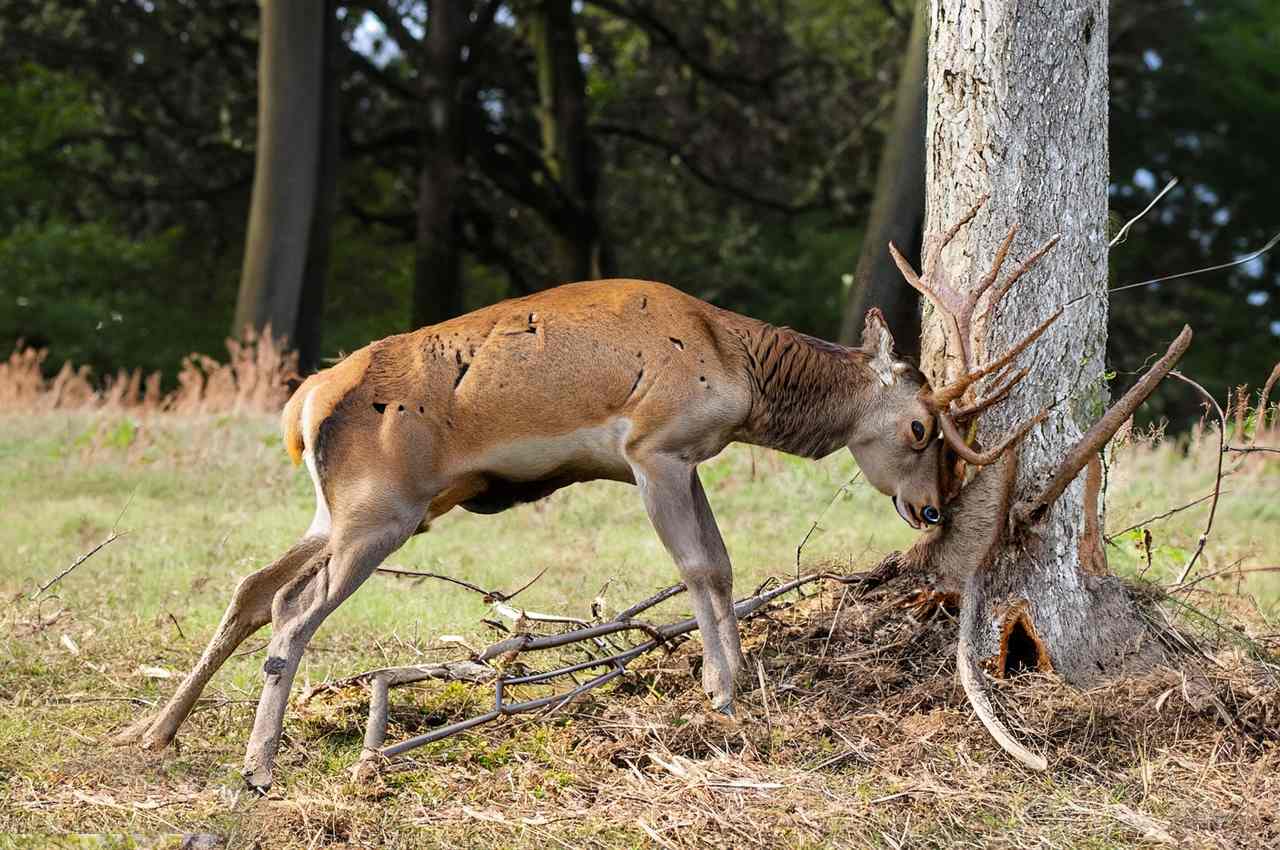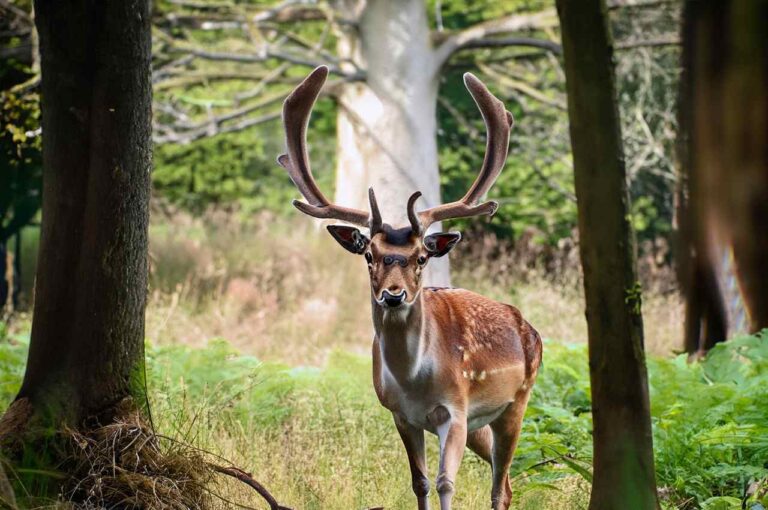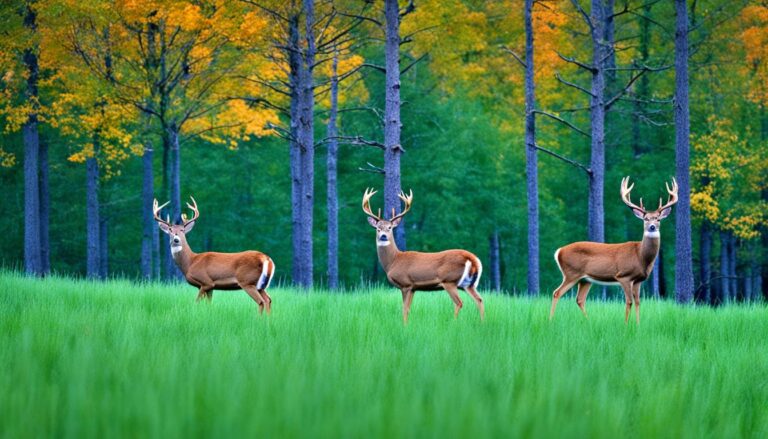How To Protect Trees From Deer: Ultimate Guide!
How to protect trees from deer is a common concern for gardeners and homeowners. Deer can wreak havoc on trees and shrubs. From browsing on foliage and buds to rubbing their antlers on bark, deer can damage or even kill trees. Protecting your landscape from deer takes some planning and effort, but is worthwhile to save your trees. This guide covers various methods to deter deer and prevent tree damage.
How To Protect Trees From Deer?
Several effective strategies may protect trees from deer. Deer repellent sprays, powders, and liquids may dissuade deer when applied following product instructions. Burlap protects the tree trunk from deer antler rubbing, whereas plastic, metal, or cloth tree guards prevent antler damage. Planting deer-resistant boxwood, lavender, and rosemary around your trees deters browsing. Though costly, a deer fence keeps deer out. DIY solutions like hanging soap bars or wrapping tree bases with human hair may protect small areas. Planting trees in groups, avoiding deer-populated areas, and routinely monitoring trees for damage like antler rubs or chewed foliage will also protect them from deer.
| Method | Description |
|---|---|
| Deer repellents | Use sprays, powders, or liquids from garden centers. Obey product labels. |
| Trunk burlapping | Prevents deer antler rubbing on tree trunks. |
| Tree guarding | Protection for the tree trunk made of plastic, metal, or cloth. |
| Deer-resistant plant planting | Choose boxwood, lavender, or rosemary to avoid deer damage. |
| Setting up a deer fence | Deer are kept out by this effective but costly method. |
| DIY with soap and hair | Deer may be deterred by hanging soap or hair around the tree. |
| Group tree planting | Planting trees together deters deer. |
| Avoiding deer trails and feeding areas | Reduce deer attractiveness by planting trees distant from their habitat. |
| Checking trees regularly | Regularly inspect for deer damage (antler rubs, chewed leaves) and respond quickly. |
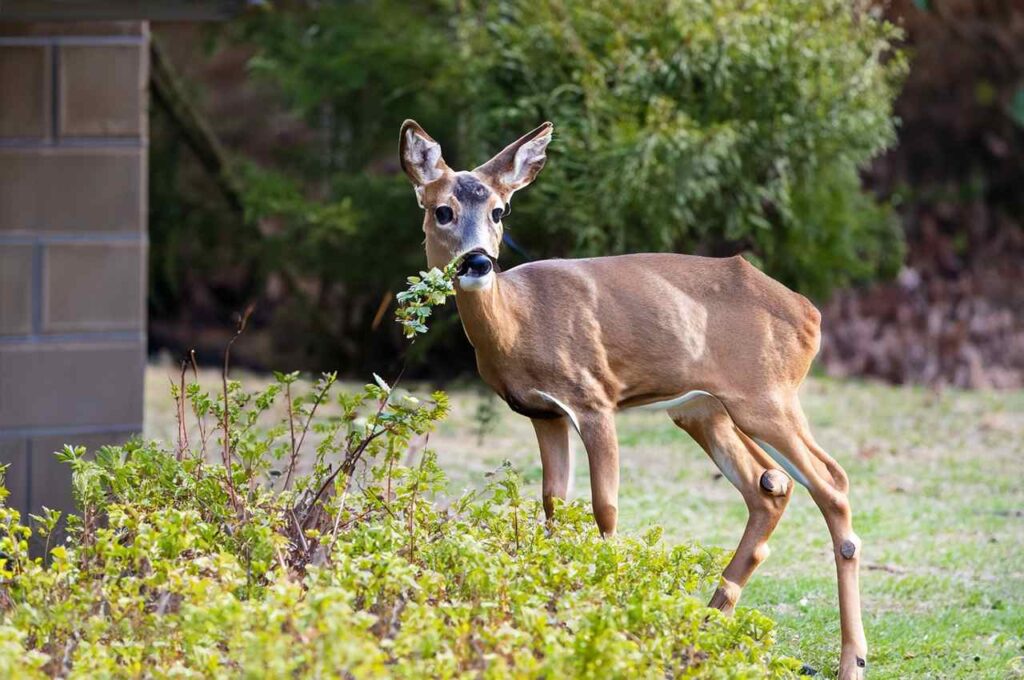
Common Deer-Resistant Plants
| Plant Type | Deer-Resistant Qualities |
|---|---|
| Spiny Shrubs | Barberry, Holly, Juniper |
| Strong Odor Plants | Lavender, Rosemary, Sage |
| Fuzzy-Leaved Plants | Lamb's Ear, Yarrow, Artemisia |
| Fern-Like Foliage Plants | Japanese Painted Fern, Ostrich Fern |
| Plants with Thorns | Roses, Hawthorn, Pyracantha |
Effective Deer Repellent Options
| Repellent Type | Characteristics |
|---|---|
| Contact Repellents | Taste bad to deer and are applied directly to trees. |
| Examples | Homemade egg and water mixtures, commercial sprays. |
| Area Repellents | Emit foul odors to deter deer from the general area. |
| Examples | Hanging deodorant soap pieces, other scented options. |
Physical Barriers for Tree Protection
| Barrier Type | Description |
|---|---|
| Tall Fencing | At least 8-10 feet high, angled outward. |
| Tree Collars | Made of PVC or heavy mesh, for young trees. |
| Plastic Tubing | Wrapped around the trunk, not too tight. |
| Chicken Wire | Can be staked or buried around the base. |
| Wire Metal Cages | At least 6 feet tall, placed around trees. |
| Burlap Wraps | Protects from deer and heavy snowfall. |
Cost-Effective Tree Protection Methods
| Protection Method | Description |
|---|---|
| Plastic Tubing | Affordable, provides a barrier around young trees. |
| Chicken Wire | Inexpensive, can be staked or buried for protection. |
| Deer Repellents | Budget-friendly options to deter deer temporarily. |
| Motion-Activated Sprinklers | Scare deer away with a water-based solution. |
Why Deer Damage Trees
Deer browse on trees and shrubs for food. They prefer buds, leaves, twigs, branches, and some types of bark. Damage is often worst in winter when other food sources are scarce. Deer also rub their antlers on tree trunks, causing bark wounds that leave trees vulnerable to insects and disease.
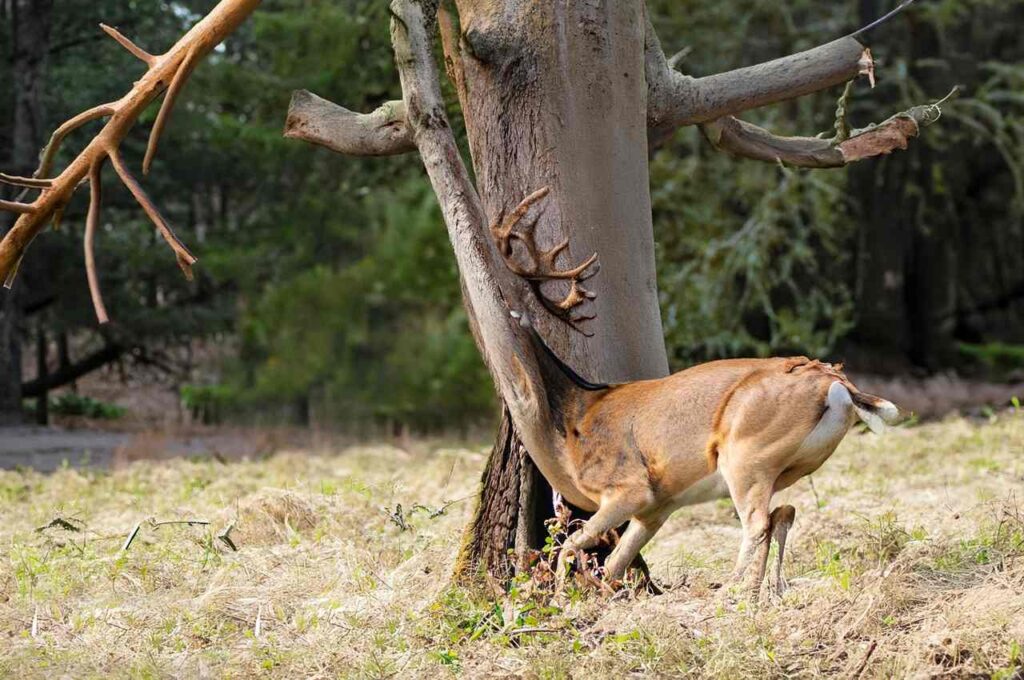
Buck deer rub trees for several reasons:
- To remove the velvet coating on their antlers in late summer/early fall
- To mark territory and attract does during mating season
- To polish antlers throughout fall and winter
Extensive antler rubbing can girdle trees and cause dieback. Young trees are most at risk since their bark is more vulnerable.
Physical Barriers for Protection
Physical barriers that prevent deer from accessing trees are the most effective deterrent. Fencing off your entire property is ideal but can be expensive. For individual trees or small areas, try these options:
- Tree Guards: Plastic or metal mesh guards wrapped around the trunk block deer from rubbing or gnawing bark. Look for spiral guards or flexible netting that allows the tree to expand.
- Wire Cages: Surround young trees with wire fencing or mesh cages at least 5-6 feet tall. Use sturdy stakes to anchor cages so deer can’t knock them over.
- Burlap: Wrap burlap around the trunks of young trees to disguise the bark. Use twine to secure it in place. Replace the burlap monthly since moisture can build up.
- Nylon Netting: Drape nylon netting over trees and shrubs to make plants less accessible to deer. Use tent stakes or U-posts to secure the netting.
- Repellent Sprays: Spraying trees with foul-tasting or smelly natural repellents may offer temporary protection. Reapply frequently, especially after rain.
- Scare Tactics: Motion-activated sprinklers, lights, or noisemakers can startle deer and make them avoid the area. Move devices occasionally so deer don’t become used to them.
- Deer Fencing: Install 8-10 ft tall plastic, wood, or woven wire fencing around your entire property to keep deer out. Use angled outriggers or electric fence for better protection. Check for gaps at ground-level that need repair.
Choose Deer-Resistant Landscaping
When planning new landscaping, select plants that deer tend to avoid. Some options include:
- Trees/Shrubs with prickles or spines like barberry, holly, pyracantha
- Plants with strong scents like lavender, sage, thyme
- Ornamental grasses
- Daffodils, irises, snapdragons
- Ferns and hostas
Avoid planting things deer love to eat such as arborvitae, euonymus, rhododendrons, and yew. Place deer-resistant plants around more vulnerable trees.
Remove Deer Attractants
Reduce tempting food sources that bring deer into your yard. Pick up fallen fruit from trees. Use a covered composter, and keep vegetable gardens fenced. Remove outdoor pet food and bird feeders at night when deer are most active.
Use Deer Repellents
Repellents create scent or taste barriers to make plants less palatable:
Homemade options: Mix eggs, hot peppers, garlic, soap, or hair in water and spray on plants. Some specific recipes:
- Blend 3 eggs, 1 cup milk, and 1 tbsp hot sauce. Strain before spraying.
- Mix 1 tbsp garlic oil and 1 tsp dish soap in 1 gallon of water.
Reapply homemade repellents after rain. They lose effectiveness over time as deer become accustomed to the smells.
Commercial repellents: Look for products containing putrescent egg solids like Deer Off. Others are made with pungent oils like cinnamon, clove, or garlic. Follow label instructions for best results.
Practice Herd Management
Where allowed, humane hunting can reduce overpopulated deer herds and associated tree damage. Target does to control reproduction rates. Local regulations may restrict firearms, seasons, etc so check first.
Be Persistent
Protecting trees from deer takes diligence and adapting as needed. Monitor young trees and replace barriers like burlap and fencing as they deteriorate. If one tactic stops working, try another. With patience and persistence, you can defend your landscape against destructive deer.
Protecting Trees from Buck Rubs
One of the most frustrating types of deer damage happens when bucks rub their antlers on tree bark. The rubbing and thrashing can shred bark, expose sapwood, and provide entry points for pests and disease. Severe buck rubs can even kill trees.
Why Bucks Rub Trees
For male deer, rubbing is a natural behavior related to the annual shedding of their antlers. Here’s some background:
- In spring and summer, antlers grow rapidly, covered in a hairy, velvet-like coating of skin called velvet. This velvet contains blood vessels that deliver nutrients for rapid growth.
- In late summer, the velvet dries up and bucks rub it off by thrashing their antlers on trees. The dried velvet hangs in shreds as it peels off.
- After shedding their velvet, bucks continue rubbing trees to polish their antlers and strengthen their neck muscles. Dominant bucks also rub trees to mark territory.
- In late winter, the antlers eventually weaken at the base and fall off, after which the cycle begins again.
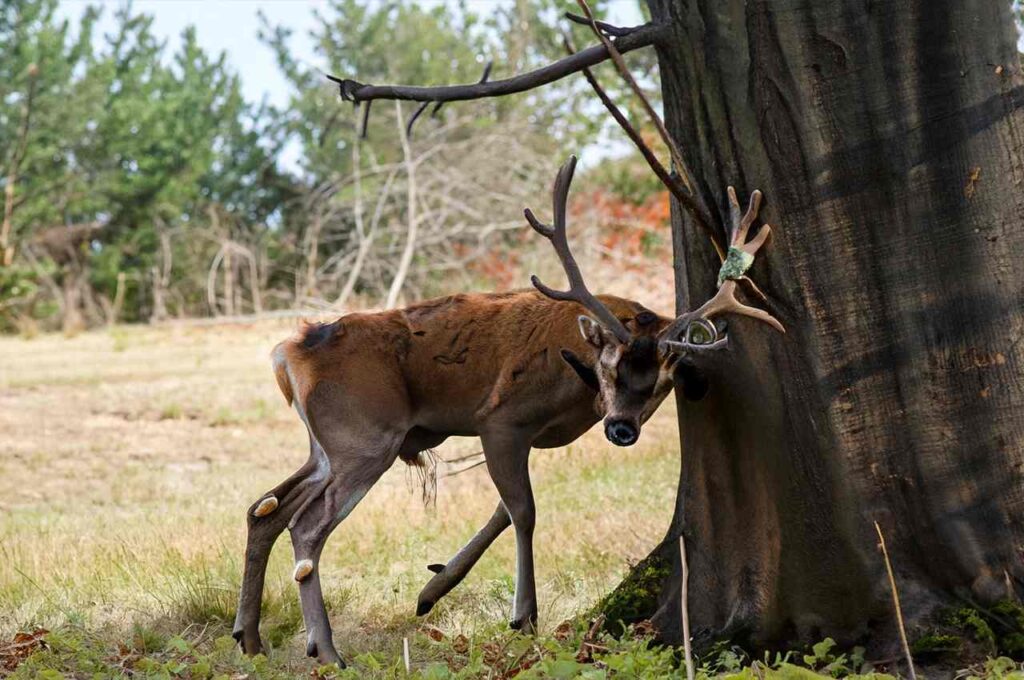
Protect Trees from Buck Rubs
To defend trees from buck rub damage:
Wrap trunks
Wrap tree trunks in burlap, flexible plastic wraps, or protective coatings like Grow-Tube. Secure with twine and remove wraps once antler shedding season passes.
Use physical barriers
Guard small trees with plastic drainage pipes, mesh cages, or triangular wood brackets. Make barriers at least 5-6 feet tall since bucks can reach high with their antlers.
Plant “rub trees”
Select a few less valuable trees in your landscape to allow bucks to rub without damaging other trees. These diversionary “rub trees” should be spread apart to disperse damage.
Try repellents
Apply foul-smelling liquid home remedies like whole eggs or garlic oil on tree trunks. Reapply frequently due to weathering.
Use scent deterrents
Hang bars of strongly scented soap from vulnerable trees to help mask their scent. Replace old bars every 4-6 weeks.
Install fencing
High fences with outriggers can prevent bucks from accessing trees. Inspect often to check for buck rub damage along the fence perimeter.
Allow access to natural forest
If bucks are rubbing ornamental landscape trees, allow them access to a natural wooded area on your property so they rub those trees instead.
When Do Bucks Shed Velvet?
In the eastern U.S., buck rubs primarily happen in October and November as deer enter the mating season or “rut” and rub off their velvet. Extensive rubbing continues through late fall and early winter. Then in December and January, mature bucks begin shedding their antlers. Protect tree trunks throughout autumn and early winter, then relax protective measures by late winter.
Staying vigilant and using multiple deterrents will help minimize annoying buck rub damage. Don’t allow deer to destroy your valuable landscape trees!
How to Fix Deer Rub Damage on Trees
If deer have already damaged your trees, prompt action can help reduce impacts and promote healing:
- Clean wounds – Carefully trim away loose bark that’s partially detached. Remove any remaining velvet or debris from the damaged area.
- Shape ragged edges – Use a sharp knife or chisel to smooth out uneven wound edges, creating a rounded shape. Avoid exposing more inner bark or sapwood.
- Apply wound sealer – Disinfect wounds and apply flexible latex paint or tree wound sealant to damaged areas. These materials protect from insects and diseases. Avoid old-fashioned tar since it can inhibit healing.
- Support split trunks – Insert wood braces between the forks of young saplings whose trunks have split from buck rubs. Secure braces with wood screws through rubber washers to avoid further bark wounds.
- Assess damage – If bark removal exceeds 50% of the trunk circumference, the entire tree may be threatened. Watch for signs of dieback on severely damaged trees.
- Protect newly wounded areas – Guard susceptible rub sites with barriers so they can heal without repeated damage each season.
- Improve growing conditions – Keep trees healthy with water during drought, mulch around the root zone, and nutrients if soil is deficient. Avoid over-pruning damaged trees.
While disheartening, deer damage can often be overcome with prompt care. Inspect wounded trees through the following growing season. With luck, they’ll gradually repair the injuries and regain vigor after deer rubs.
Deer-Resistant Trees and Shrubs
Choosing plants that deer avoid can eliminate damage without unsightly fencing. Here are some trees and shrubs deer tend to bypass:
Trees:
- Birch
- Dogwood
- Silver maple
- Winterberry holly
- Eastern red cedar
- Paper mulberry
- Japanese maple
Shrubs:
- Barberry
- Sumac
- Beautyberry
- SageLavender
- Rosemary
- Oregano
- Yukon bell
- Poison ivy
Ornamental grasses:
- Maiden grass
- Fountain grass
- Japanese silver grass
- Tufted hair grass
Vines:
- Trumpet honeysuckle
- Clematis
Groundcovers:
- Lenten rose
- Wild ginger
- Common snowdrop
- Epimedium
- Hellebore
Perennials:
- Bleeding heart
- Daffodil
- Siberian iris
- Peony
- Russian sage
- Euphorbia
Plant these less-favored species near trees and shrubs that need protection from deer browse. Focus on planting densely around the perimeter to block access.
Frequently Asked Questions
What is the cheapest way to protect trees from deer?
Use of physical barriers, such as nylon netting, burlap sacks, wire cages, tree wrap, or tree guards, is the most economical technique to keep deer away from trees. These alternatives may be adjusted to meet the size and kind of tree you wish to protect, and they are reasonably priced.
How do you keep deer from eating your trees?
Installing high fences, using tree collars or barriers for young trees, applying deer repellents, getting a dog to scare off deer, planting deer-resistant vegetation around your trees, and using motion-activated sprinklers to surprise and scare off deer are all ways to prevent deer from eating your trees.
How do you protect a large tree from deer?
Although protecting huge trees from deer might be difficult, it is nevertheless possible with the help of fencing choices like exclusion or deer-proof fencing. The trunks may also be protected by placing wire cages around them or by wrapping them with tree wrap.
What can I use to protect my small tree from deer?
Use solutions like nylon netting, burlap sacks, wire cages, tree wrap, or tree guards to keep deer away from tiny trees. These techniques are very useful for protecting young and delicate trees.
What natural things keep deer away?
Deer-resistant vegetation, strong-smelling soaps, coffee grounds, garlic, mothballs, rotting fish heads, processed sewage, hair, blood meal, fabric softener, and motion-activated sprinklers are a few natural deer deterrents.
What smell do deer hate the most?
Strong aromas like those of garlic, coffee grinds, and certain soaps are often not liked by deer. These smells may keep them away from certain garden regions or plants.
What are deer most afraid of?
Deer often avoid abrupt movements, loud sounds, and strange smells or things. Deer may be discouraged by using deterrents as deer repellent soaps, motion-activated sprinklers, noisemakers, and other means of creating an unfamiliar and sometimes terrifying environment.
Does fertilizer repel deer?
Fertilizer alone is not typically used as a deer repellent. However, certain repellents could also include fertilizing elements and/or compounds with disagreeable tastes or scents that might discourage deer from nibbling on plants. It’s crucial to choose repellents made especially for keeping deer away.
What can I spray on my trees to keep deer away?
You may build your own deer repellent at home in addition to buying a variety of commercial ones. A gallon sprayer filled with four eggs, two cups of water, and one tablespoon of dish soap is one efficient recipe. Spray the mixture liberally on the tree’s whole surface, including the branches, leaves, and trunk. Reapply immediately after rain or vigorous watering.
Using a deer repellent produced from putrified eggs is an additional option. Although incredibly powerful, this kind of repellant may also be rather pungent. Simply put a dozen eggs and a gallon of water in a sealed container to produce your own. Until the eggs have entirely putrefied, keep the container in a warm location for a few weeks. Spray the concoction on your trees after the eggs have gone bad.
Does burlap protect trees from deer?
Burlap may be used to shield trees from the rubbing of deer antlers, but it must be applied properly. Wrap the burlap around the tree’s trunk beginning at the bottom and working your way up to complete this. Make sure the burlap is at least six inches overlapped. The burlap may be fastened in place using wire or yarn.
It’s crucial to routinely inspect the burlap to make sure it’s still in good condition. Replace the burlap right away if it is ripped or damaged. In the spring, once the deer have lost their antlers, burlap should be taken down from trees.
What are some DIY tricks for keeping bucks away from trees?
You may use a variety of do-it-yourself techniques to keep deer away from your trees. Hanging bars of soap from the tree’s branches is one common practice. Deer will stay away because of the soap’s fragrance.
Another option is to strew human hair all around the tree’s base. Deer are very sensitive to the smell of people and will stay away from certain regions. You may either ask a friend or member of your family for their hair or gather human hair from your own hairbrush.
A motion-activated sprinkler may also be used to deter deer from approaching your trees. The sprinkler will be triggered by movement when a deer passes by and will shower the animal with water. This will scare the deer and make them reluctant to come back.
How effective are sprinklers that run on motion detectors at scaring deer away?
Sprinklers that are actuated by movement may be quite successful in driving deer away. However, it’s crucial to carefully position the sprinklers. Place them in locations where deer are likely to go, such as close to feeding sites or deer routes. In order to prevent the deer from coming back, you need also alter the sprinklers so that they spray in a certain manner.
Maintaining the sprinklers’ functionality is also crucial. Make sure the sprinklers can be activated by high enough water pressure and new batteries.
What is the best way to protect trees from deer antler rubbing?
Using a variety of techniques is the best approach to guard against deer antler rubbing on trees. Burlap wrapped around the tree’s trunk is one practical solution. Utilizing a tree guard is still an alternative. Tree guards may be constructed from a range of materials, including cloth, metal, and plastic. They are designed to shield the tree’s trunk from wear and tear from rubbing deer antlers.
To stop deer from rubbing their antlers on your trees, you may also try spraying repellant on them. Sprays that repel animals are often sold in garden centers. Pay close attention to the instructions on the product label.
How effective are repellent sprays for preventing deer rub problems?
Sprays that repel deer may help reduce issues with deer rub, but they are not always completely successful. Deer may eventually become acclimated to the repellent’s scent and begin to disregard it. In order to keep the deer guessing, it’s crucial to reapply the repellent often and to use a range of different solutions.
To prevent deer antler rubbing on your trees, you need also take extra precautions in addition to utilizing repellent sprays. For instance, you may use a tree guard or burlap to cover the tree’s trunk. You may also try surrounding your trees with plants that are resistant to deer.
Conclusion
Knowing how to protect trees from deer damage can save your landscape and is crucial to maintain the health, beauty, and value of your landscape. A multi-pronged approach works best against these frustrating yet amazing animals. Combine fencing, repellents, deer-resistant plantings, scare tactics, and herd management for success. Stay alert for new damage and be willing to try different remedies if one method fails. With persistence, you can defend your trees against deer!
- Wyoming Deer Season 2025-2026 New Schedule & Rules - 15 September 2025
- Wisconsin Deer Season 2025-2026: WI Deer Hunting Guide [Schedule, Rules, Licenses] - 15 September 2025
- West Virginia Deer Season 2025-2026 Complete Date & Guide - 15 September 2025
